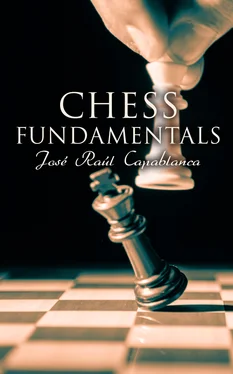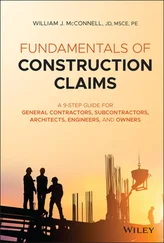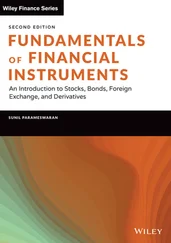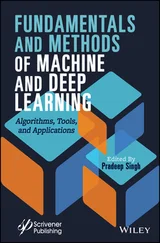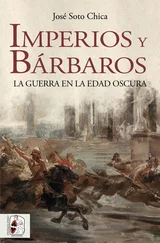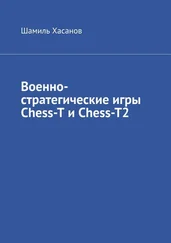José Raúl Capablanca
Theory, Strategy and Principles of Chess
e-artnow, 2021
Contact: info@e-artnow.org
EAN: 4064066388874
Part I PART I Table of Contents
Chapter I. First Principles: Endings, Middle-Game and Openings
Chapter II. Further Principles in End-Game Play
Chapter III. Planning a Win in Middle-Game Play
Chapter IV. General Theory
Chapter V. End-Game Strategy
Chapter VI. Further Openings and Middle-Games
Part II
Game 1. Queen's Gambit Declined
Game 2. Queen's Gambit Declined
Game 3. Irregular Defence
Game 4. French Defence
Game 5. Ruy Lopez
Game 6. French Defence
Game 7. Ruy Lopez
Game 8. Centre Game
Game 9. Queen's Gambit Declined
Game 10. Petroff Defence
Game 11. Ruy Lopez
Game 12. French Defence
Game 13. Ruy Lopez
Game 14. Queen's Gambit Declined
Table of Contents
CHAPTER I
FIRST PRINCIPLES: ENDINGS, MIDDLE-GAME AND OPENINGS
Table of Contents
The first thing a student should do, is to familiarise himself with the power of the pieces. This can best be done by learning how to accomplish quickly some of the simple mates.
1. SOME SIMPLE MATES
Example 1.—The ending Rook and King against King.
The principle is to drive the opposing King to the last line on any side of the board .
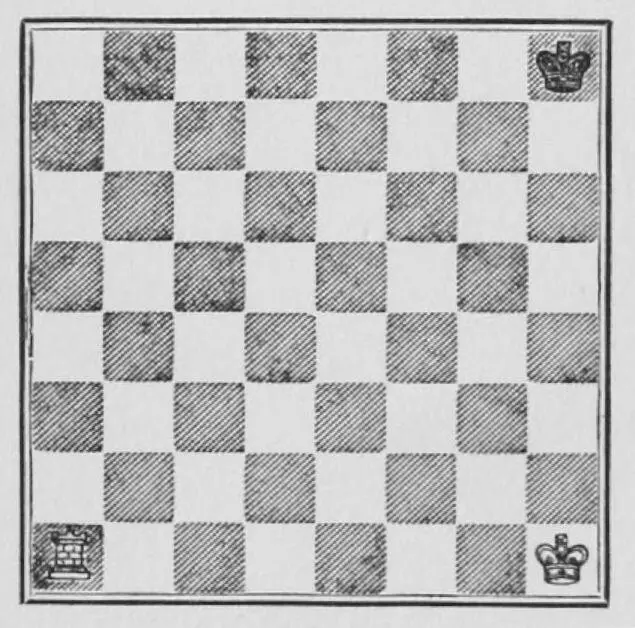
In this position the power of the Rook is demonstrated by the first move, R - R 7, which immediately confines the Black King to the last rank, and the mate is quickly accomplished by: 1 R - R 7, K - Kt 1; 2 K - Kt 2.
The combined action of King and Rook is needed to arrive at a position in which mate can be forced. The general principle for a beginner to follow is to
keep his King as much as possible on the same rank, or, as in this case, file, as the opposing King.
When, in this case, the King has been brought to the sixth rank, it is better to place it, not on the same file, but on the one next to it towards the centre.
2...K - B 1; 3 K - B 3, K - K 1; 4 K - K 4, K - Q 1; 5 K - Q 5, K - B 1; 6 K - Q 6.
Not K - B 6, because then the Black King will go back to Q 1 and it will take much longer to mate. If now the King moves back to Q 1, R - R 8 mates at once.
6...K - Kt 1; 7 R - Q B 7, K - R 1; 8 K - B 6, K - Kt 1; 9 K - Kt 6, K - R 1; 10 R - B 8 mate.
It has taken exactly ten moves to mate from the original position. On move 5 Black could have played K - K 1, and, according to principle, White would have continued 6 K - Q 6, K - B 1 (the Black King will ultimately be forced to move in front of the White King and be mated by R - R 8); 7 K - K 6, K - Kt 1; 8 K - B 6, K - R 1; 9 K - Kt 6, K - Kt 1; 10 R - R 8 mate.
Example 2.
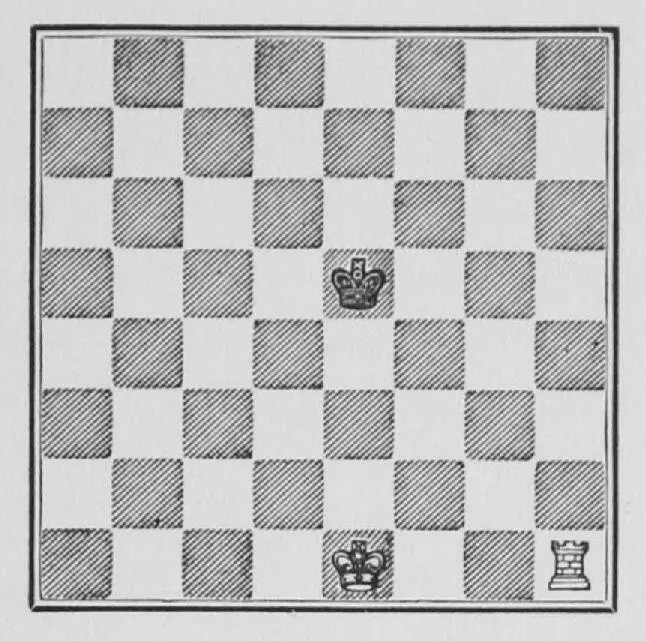
Since the Black King is in the centre of the board, the best way to proceed is to advance your own King thus: 1 K - K 2, K - Q 4; 2 K - K 3. As the Rook has not yet come into play, it is better to advance the King straight into the centre of the board, not in front, but to one side of the other King. Should now the Black King move to K 4, the Rook drives it back by R - R 5 ch. On the other hand, if 2... K - B 5 instead, then also 3 R - R 5. If now 3... K - Kt 5, there follows 4 K - Q 3; but if instead 3... K - B 6; then 4 R - R 4, keeping the King confined to as few squares as possible.
Now the ending may continue: 4...K - B 7; 5 R - B 4 ch, K - Kt 6; 6 K - Q 3, K - Kt 7; 7 R - Kt 4 ch, K - R 6; 8 K - B 3, K - R 7. It should be noticed how often the White King has moved next to the Rook, not only to defend it, but also to reduce the mobility of the opposing King. Now White mates in three moves thus: 9 R - R 4 ch, K - Kt 8; 10 R - any square on the Rook's file, forcing the Black King in front of the White, K - B 8; 11 R - R 1 mate. It has taken eleven moves to mate, and, under any conditions, I believe it should be done in under twenty. While it may be monotonous, it is worth while for the beginner to practice such things, as it will teach him the proper handling of his pieces.
Example 3.—Now we come to two Bishops and King against King.
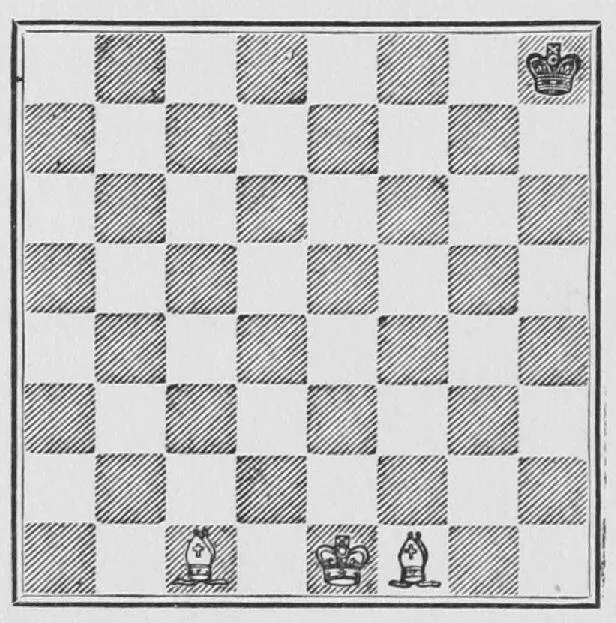
Since the Black King is in the corner, White can play 1 B - Q 3, K - Kt 2; 2 B - K Kt 5, K - B 2; 3 B - B 5, and already the Black King is confined to a few squares. If the Black King, in the original position, had been in the centre of the board, or away from the last row, White should have advanced his King, and then, with the aid of his Bishops, restricted the Black King's movements to as few squares as possible.
We might now continue: 3...K - Kt 2; 4 K - B 2. In this ending the Black King must not only be driven to the edge of the board, but he must also be forced into a corner, and, before a mate can be given, the White King must be brought to the sixth rank and, at the same time, in one of the last two files; in this case either K R 6, K Kt 6, K B 7, K B 8, and as K R 6 and K Kt 6 are the nearest squares, it is to either of these squares that the King ought to go. 4...K - B 2; 5 K - Kt 3, K - Kt 2; 6 K - R 4, K - B 2; 7 K - R 5, K - Kt 2; 8 B - Kt 6, K - Kt 1; 9 K - R 6, K - B 1. White must now mark time and move one of the Bishops, so as to force the Black King to go back; 10 B - R 5, K - Kt 1; 11 B - K 7, K - R 1. Now the White Bishop must take up a position from which it can give check next move along the White diagonal, when the Black King moves back to Kt 1. 12 B - K Kt 4, K - Kt 1; 13 B - K 6 ch, K - R 1; 14 B - B 6 mate.
It has taken fourteen moves to force the mate and, in any position, it should be done in under thirty.
In all endings of this kind, care must be taken not to drift into a stale mate.
In this particular ending one should remember that the King must not only be driven to the edge of the board, but also into a corner. In all such endings, however, it is immaterial whether the King is forced on to the last rank, or to an outside file, e.g. K R 5 or Q R 4, K 1 or Q 8.
Example 4.—We now come to Queen and King against King. As the Queen combines the power of the Rook and the Bishop, it is the easiest mate of all and should always be accomplished in under ten moves. Take the following position:
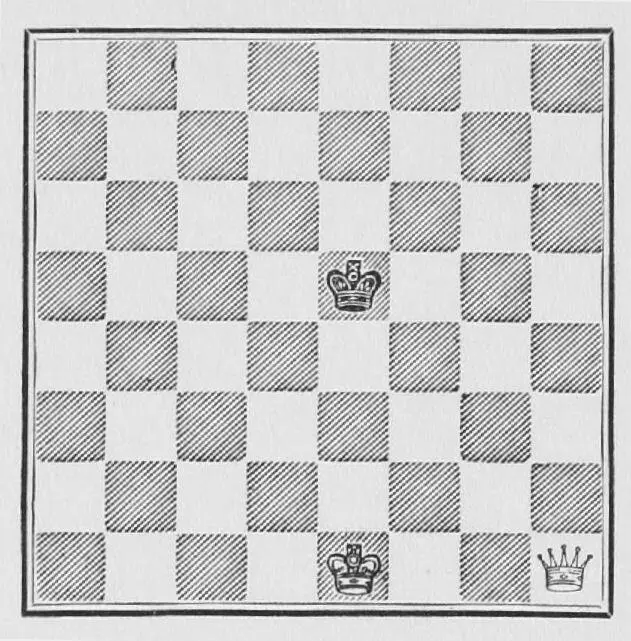
A good way to begin is to make the first move with the Queen, trying to limit the Black King's mobility as much as possible. Thus: 1 Q - B 6, K - Q 5; 2 K - Q 2. Already the Black King has only one available square 2...K - K 4; 3 K - K 3, K - B 4; 4 Q - Q 6, K - Kt 4. (Should Black play K - Kt 5, then Q - Kt 6 ch); 5 Q - K 6, K - R 5 (if K - R 4, K - B 4 and mate next move); 6 Q - K Kt 6, K - R 6; 7 K - B 3, K moves; 8 Q mates.
In this ending, as in the case of the Rook, the Black King must be forced to the edge of the board; only the Queen being so much more powerful than the Rook, the process is far easier and shorter. These are the three elementary endings and in all of these the principle is the same. In each case the co-operation of the King is needed. In order to force a mate without the aid of the King, at least two Rooks are required.
Читать дальше
